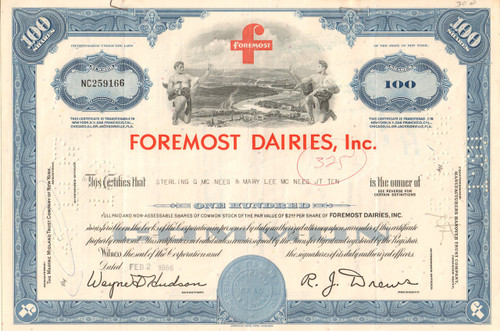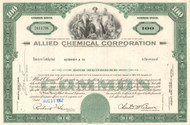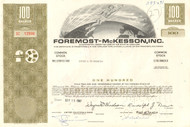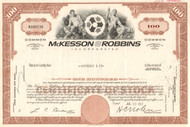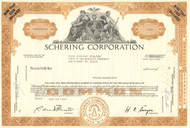Categories
Categories
- Home
- Food and Beverage
- Food Brands
- Foremost Dairies Inc. 1960's (now part of McKesson)
Foremost Dairies Inc. 1960's (now part of McKesson)
Product Description
Foremost Dairies Inc. stock certificate 1960's (now part of McKesson)
Nice vignette with the red company logo above a river scene flanked by two classical male figures. Issued and cancelled. Dated early 1960's.
In 1967, McKesson & Robbins merged with Foremost Dairies of San Francisco to form Foremost-McKesson Inc. At the time, Foremost-McKesson included chemical, liquor and pharmaceutical companies as well as Foremost Foods Company.
McKesson Corporation is an American company distributing pharmaceuticals at a retail sale level and providing health information technology, medical supplies, and care management tools. The company had sales of $122 billion in 2012. It is a Fortune Global 500 company, and the 11th highest revenue generating company in the United States.
McKesson is based in the United States and distributes health care systems, medical supplies and pharmaceutical products. Additionally, McKesson provides extensive network infrastructure for the health care industry; also, it was an early adopter of technologies like bar-code scanning for distribution, pharmacy robotics, and RFID tags.
Founded in New York City as Olcott & McKesson by Charles Olcott and John McKesson in 1833, the business began as an importer and wholesaler of botanical drugs. A third partner, Daniel Robbins joined the enterprise as it grew, and it was renamed McKesson & Robbins following Olcott's death in 1853.
The company successfully emerged from one of the most notorious business/accounting scandals of the 20th century—the McKesson & Robbins scandal, a watershed event that led to major changes in American auditing standards and securities regulations after being exposed in 1938.
Since the mid-20th Century, McKesson has derived an increasing proportion of its income from medical technology, rather than pharmaceuticals. This culminated in its purchase of medical information systems firm HBO & Company (HBOC) in 1999; the combined firm was briefly known as McKessonHBOC. Accounting irregularities at HBOC reduced the company's share price by half, and resulted in the dismissal and prosecution of many HBOC executives. The firm's name reverted to "McKesson" in 2001. McKesson Technology Solutions, as the information technology branch of the company is now known, has continued to increase its market share through acquisitions, notably Per Se Technologies, RelayHealth, and Practice Partner. In 2010, McKesson acquired leading cancer services company US Oncology, Inc. for $2.16 billion, which was integrated into the McKesson Specialty Care Solutions business.
McKesson Provider Technologies is the retail name for McKesson Technology Solutions; the software development division of McKesson. Their customer base in the United States includes 50% of all health systems, 20% of all physician practices, 25% of home care agencies, and 77% of health systems with more than 200 beds.
On June 20, 2005, McKesson Provider Technologies acquired Medcon, Ltd., an Israeli company which provides Web-based cardiac image and information management solutions for heart centers, that includes: diagnostic digital image management, archiving, procedure reporting, and workflow management. In October 2013, McKesson agreed to buy a 50% stake in German peer Celesio for $8.3 billion.
Health Mart is a network of over 3,400 independently owned and operated pharmacies. It is a wholly owned subsidiary of McKesson Corporation, which owns the name "Health Mart." McKesson acquired Health Mart owner FoxMeyer in 1996.
In 1991, McKesson Corporation acquired a 100 percent interest in Medis Health and Pharmaceutical Services from Provigo. In 2002, the McKesson Canada name was adopted. McKesson Canada is a wholly owned subsidiary of McKesson Corporation. It includes various business units: McKesson Pharmaceutical, McKesson Automation, McKesson Specialty, McKesson Health Solutions and McKesson Information Solutions.
In the United Kingdom, McKesson (operating as McKesson Information Solutions UK Ltd) is a provider of information technology services to the health care industry. In addition to numerous clinical software systems and finance and procurement services, McKesson also is responsible for developing the Electronic Staff Record system for the National Health Service which provides an integrated payroll system for NHS's 1.3 million staff, making it the world’s largest single payroll IT system. McKesson Shared Services also provides payroll services for over 20 NHS Trusts, paying over 100,000 NHS members.
McKesson's United Kingdom base is in Warwick with data centers in Newcastle upon Tyne and Brent Cross and offices in Sheffield, Bangor, Glasgow and Vauxhall, London. Across the United Kingdom, it employs over 500 people.
In Jun/Jul 2014 McKesson sold most of their healthcare software business to the private equity firm Symphony Technology Group and indicated also that they would not be re-bidding for the Electronic Staff Record contract.
McKesson ANZ is a fully owned subsidiary of McKesson Corporation. McKesson expanded its footprint in Australia and New Zealand by acquiring Emendo in November, 2012. McKesson ANZ develops and sells healthcare optimization services and software. The company has traditionally been focused on the public markets in Australia and New Zealand. The majority of the District Health Boards in NZ use one or more of McKesson’s Capacity Management solutions.
Christchurch, New Zealand is one of McKesson’s global Capacity Management R&D centers of excellence. All of McKesson’s R&D for McKesson Capacity Planner is performed in New Zealand. The company employs approximately 40 team members across Australia and New Zealand including general management, R&D, sales, services and support employees.
McKesson Capacity Planner (formerly, Emendo CapPlan) is used in more than 40 hospitals in Australia, New Zealand, Britain, Canada and the US to forecast future patient activity and help health systems to allocate resources efficiently and identify unnecessary costs.
 Loading... Please wait...
Loading... Please wait... 
